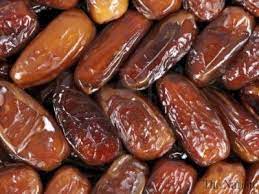Figs (Anheer)
Fig (Anjeer)
It is commonly known as Angeer .It is a soft pear-shaped fruit with sweet dark flesh and many small seeds, eaten fresh or dried.
In market it is generally available in dry form all year around.
Health Benefits of eating figs
Having figs in diet is very beneficial for our health. They are
a very good natural source of soluble fiber, sugar, a number of minerals &
Vitamins and Energy.
Improve Our Digestion
From a long time Angeer is supposed to improve our digestion
and give relief in constipation and making our intestine strong.
Due to its high soluble fiber it acts as a natural laxative
and help in improving bowel movement
Improve Blood Pressure
It is a good source of potassium which is supposed to improve blood pressure
Help in Weight loss by Dieting
Having 2-3 Angeer between two longer meals gap during diet
do not you feel Hungary.
Improve Fertility
Because of its high iron content it is supposed to improve
fertility of both male and female.
It is generally taken with milk to improve reproductive
health.
Good for Heart Health
It help in reducing bad cholesterol and excess fat from the body and thus improve
heart health.
|
Nutritional value per 100 g (3.5 oz)* |
|||
|
Energy |
310 kJ (74 kcal) |
||
|
Carbohydrates |
19.2 g |
||
|
Sugars |
16.3 g |
||
|
Dietary fiber |
3 g |
||
|
Fat |
0.3 g |
||
|
Protein |
0.8 g |
||
|
Vitamins |
Quantity |
%DV† |
|
|
Vitamin A equiv. |
7 μg |
1% |
|
|
Thiamine (B1) |
0.06 mg |
5% |
|
|
Riboflavin (B2) |
0.05 mg |
4% |
|
|
Niacin (B3) |
0.4 mg |
3% |
|
|
Pantothenic acid (B5) |
6%0.3 mg |
Pantothenic acid (B5) |
|
|
Vitamin B6 |
0.1 mg |
8% |
|
|
Folate (B9) |
6 μg |
2% |
|
|
Vitamin C |
2 mg |
2% |
|
|
Vitamin E |
0.11 mg |
1% |
|
|
Vitamin K |
4.7 μg |
4% |
|
|
Minerals |
Quantity |
%DV† |
|
|
Calcium |
35 mg |
4% |
|
|
Iron |
0.4 mg |
3% |
|
|
Magnesium |
17 mg |
5% |
|
|
Manganese |
0.13 mg |
6% |
|
|
Phosphorus |
14 mg |
2% |
|
|
Potassium |
232 mg |
5% |
|
|
Sodium |
232 mg |
0% |
|
|
Zinc |
0.15 mg |
2% |
|
|
Other constituents |
Quantity |
||
|
Water |
79 g |
||
|
*Percentages are roughly approximated using US recommendations for
adults. Source: USDA Food Data Central |
|||
Religious Reference of Figs
·
Sura 95 of the Qur'an is
named al-Tīn (Arabic for "The Fig"), as it opens with the oath
"By the fig and the olive." The fruit is also mentioned elsewhere in
the Qur'an. Within the Hadith, Sahih al-Bukhari records Muhammad stating:
"If I had to mention a fruit that descended from paradise, I would say
this is it because the paradisiacal fruits do not have pits...eat from these
fruits for they prevent hemorrhoids, prevent piles and help gout.
·
According to Hindu
scriptures, asvattha (Sanskrit: अश्वत्थ,
IAST: aśvattha) (or Assattha) at is, the Sacred Fig, is a sacred tree for the
Hindus and has been extensively mentioned in texts pertaining to Hinduism,
mentioned as 'peepul' (Ficus religiosa) in Rig Veda mantra I.164], a tree under
which Gautam Buddha meditated and gained enlightenment.
·
In the Biblical Book of
Genesis, Adam and Eve clad themselves with fig leaves (Genesis 3:7) after
eating the "forbidden fruit" from the tree of the knowledge of good
and evil.
· According to the Aggadah (Jewish text), the
forbidden fruit of the Tree of Knowledge in the Garden of Eden was not an
apple, but a fig
Disclaimer: The information in this website is just for general understanding and educational purpose and is not meant for any type of medical treatment as every individual reader has its own unique requirement. The reader should consult their physician or dietitian before taking any edible for any treatment purpose.



Comments
Post a Comment